
|
|
Für die deutsche Fassung bitte nach unten scrollen
|
|
|
|
Happy New Year! Or as the Romans would say: "Annum novum faustum felicem!"
|
Record Prices for Antiquities. The December auctions in Great Britain, Germany and France made it obvious – the prices for ancient art are rising fast. In London a collection of Sabaean art came under the hammer at Sotheby's with some objects fetching well over 200 000 Pounds. All the more we are pleased to offer you in this newsletter a wonderful alabaster head from the kingdom of the Queen of Sheba with almost 100 years of provenance at a highly attractive price. And: We are showing two more published military diplomas from Peter Weiß' unique collection, almost all of which we were able to acquire. Such an opportunity, that is certain, will not come back anytime soon either.
|
|
|
|
Our Highlight of the Month:
|
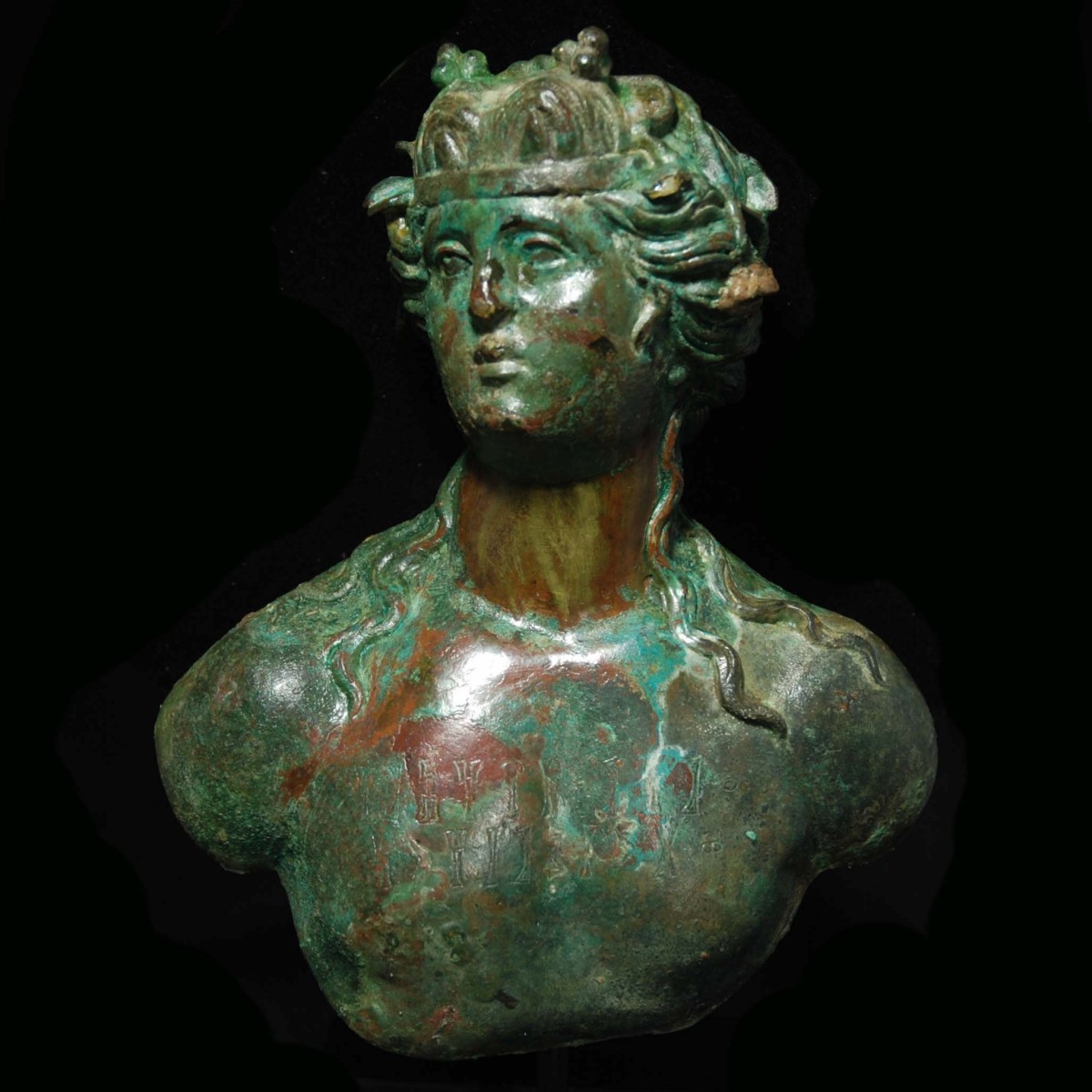
|
|
|
|
|
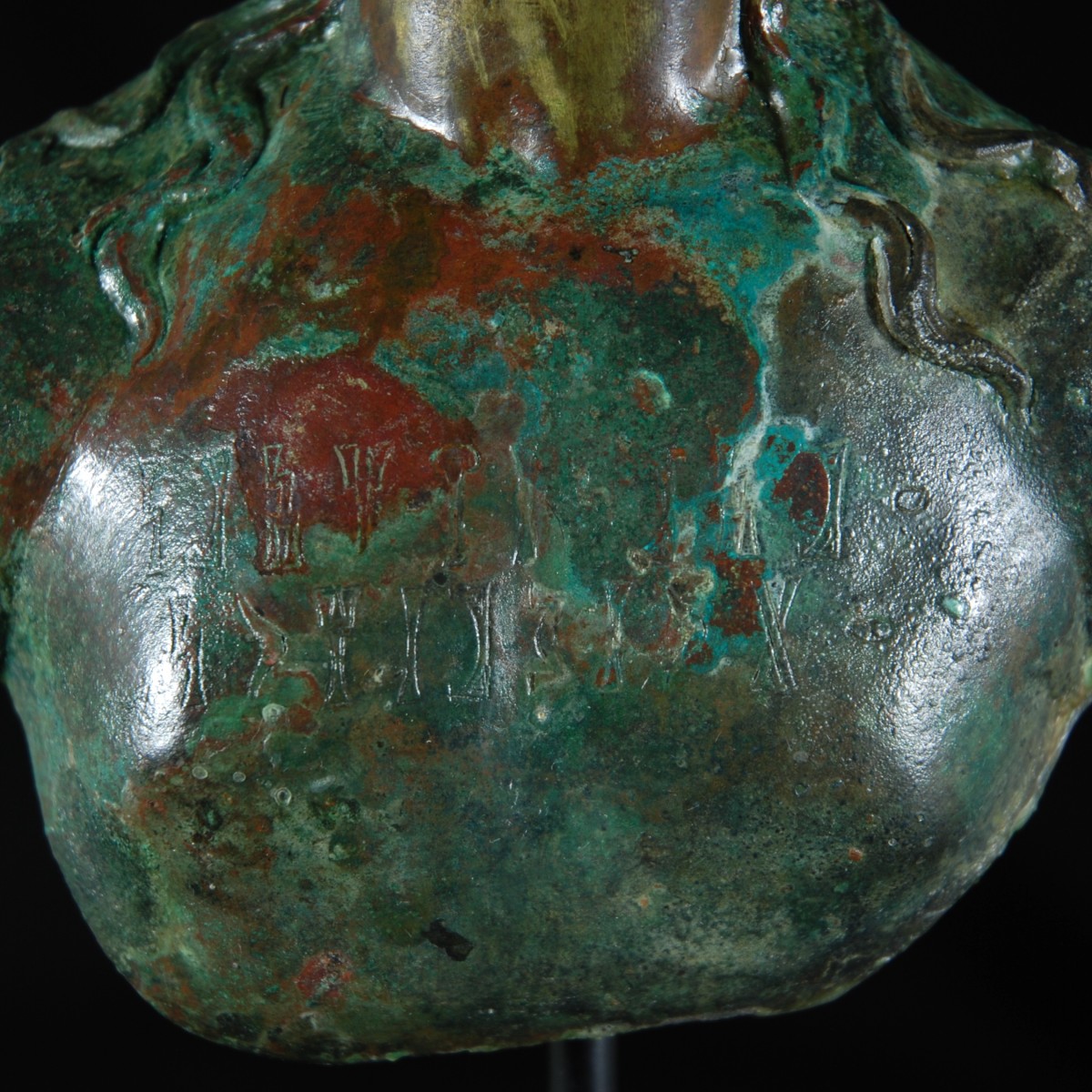
|
|
Roman Empire/Arabia Felix – 1st century A.D.
|
Important and high-quality bronze bust of Dionysus with a two-line inscription above the chest. The powerfully depicted god with a naked upper body and finely modelled chest- and upper arm musculature. The head facing to the right and in the style of the Hellenistic Alexander portraits gazing into the distance. Dionysus has his thick hair parted in the centre and pulled back into a bun. Long strands cascade right and left to the shoulder. The god wears a wreath of grapes and leaves, which adorn his head. Engraved on his chest is a two-line dedication in South Arabian letters. The inscription reads: "Amm’aman Yuha’min Watar has erected (this bust) in Hirran." According to Francois Bron, the worldwide leading expert for Sabaean inscriptions, it is of extraordinary rarity that the non-royal name Amm’aman is affixed with even two surnames, i.e. Yuha-min and Watar. The bust of finest quality was inspected by Bron in the Moussaieff collection, published and described in “Ètudes Bibliques et Proche-Orient ancien – Mélanges offerts au Père Paul Feghali”, Subsidia 1, page 40, Beirut 2002. Mounted.
|
Provenance: Private collection Shlomo Moussaieff (1925-2015), Israel. Acquired between 1948 and 2000. With a copy of the publication by Francois Bron.
Dimensions: 18.5 cm high
Price: 28 000 Euro
|
|
|
|
Selected Artworks of the Month:
|
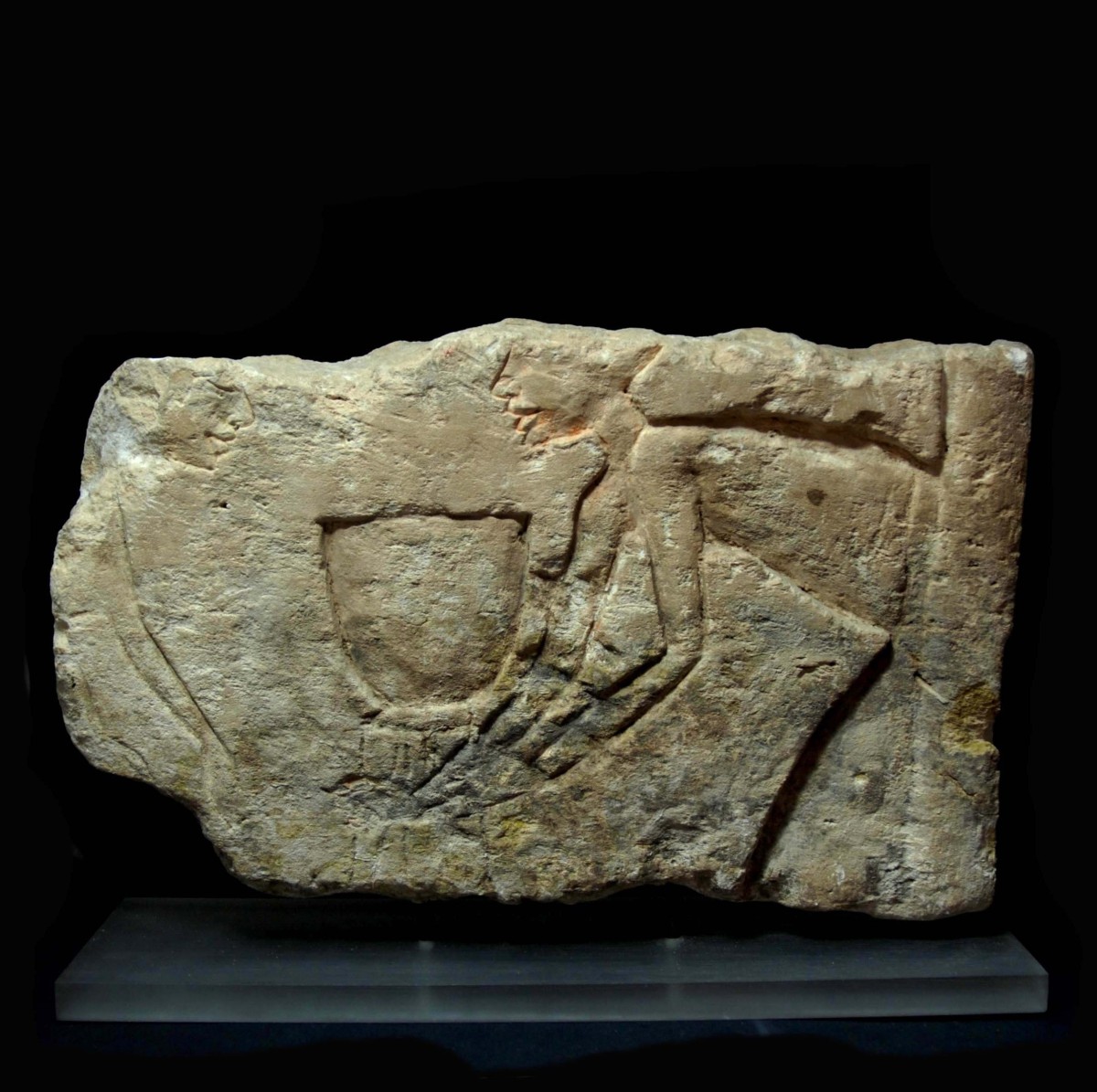
|
|
|
|
Egypt – 18th dynasty, Amarna period, 1351-1334 B.C.
|
Large limestone fragment from the Amarna period under the reign of pharaoh Akhenaten. Depicted are two figures bending to each other. The right, male figure wears a long, straight kilt and places a large vase on a tripod. The left figure also reaches with its long arms to the vase. It is possible that the right figure, probably a member of the royal family, is depicted leaving a building, after a model which is documented in the royal tomb in El-Amarna. See for this hypothesis G. Thorndike Martin, “The Royal Tomb at El-'Amarna”, London, 1989, table 34. The faces with the elliptical eyes, the prominent noses and chins are equally typical for the art of the Amarna period as the over-long, slender arms and limbs. Mounted.
|
Provenance: New York private collection S. Carroll, acquired 1969. Thence with Bonhams London on 28 November 2017, lot 16.
Dimensions: 23.5 cm x 38 cm
Price: 28 000 Euro
|
|
|
|
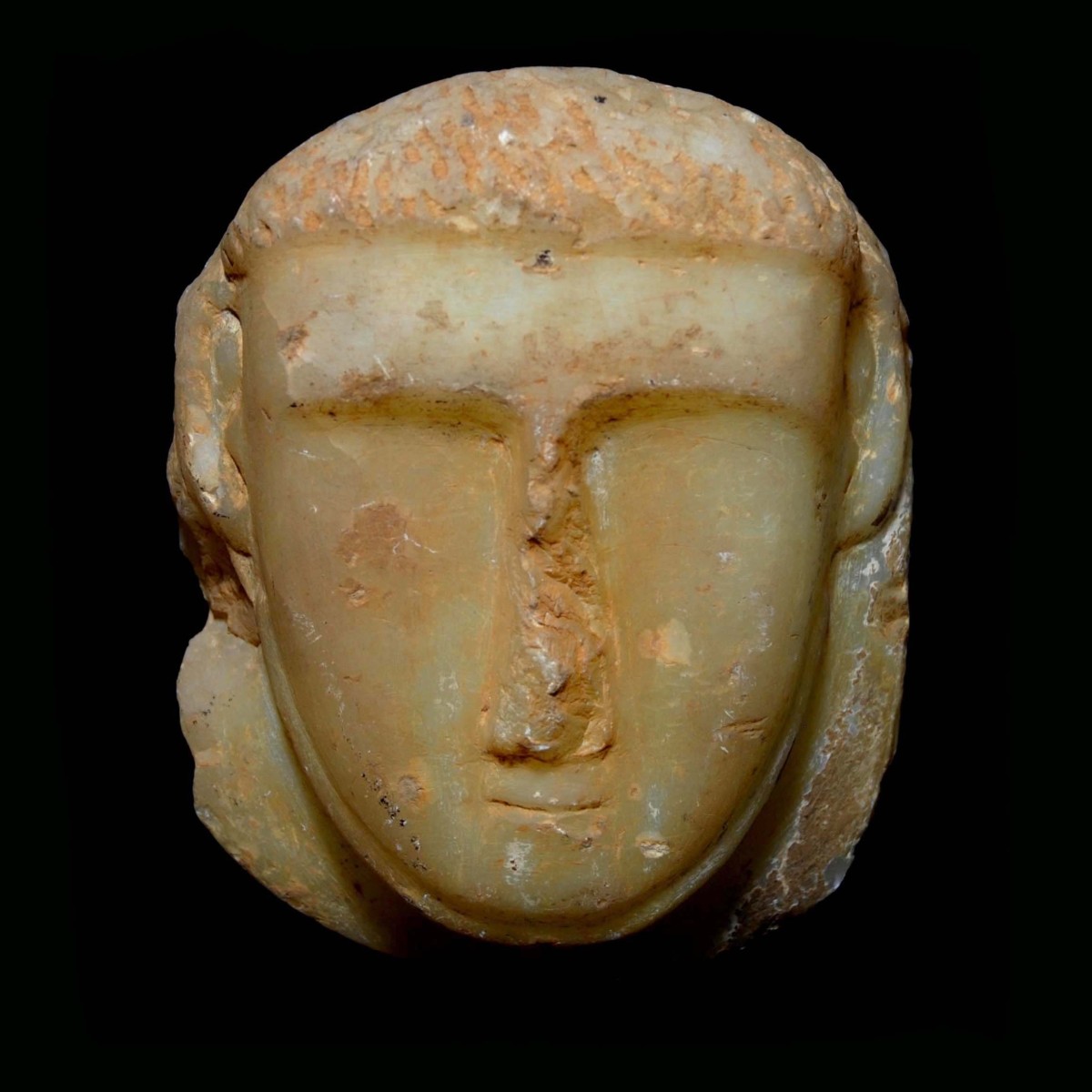
|
|
Kingdom of Saba – 3rd-2nd century B.C.
|
Stylized head stele of a bearded man with an oval face. The nose is long and slender, the smiling mouth thin. Starting from the worked out ears a thin beard line frames the lower face half. The hair line is worked out, the hair is indicated by small engravings. The eye sockets are formed by the right angle of the nose and eye brows. A highly stylized head with a strong expression from the early Arabian period. See for the type the face steles of the Eduard Glaser collection in the Kunsthistorisches Museum in Vienna. Due to the collection history of the present head, which was in a Viennese family estate at least for 80 years, it is assumed that this example originally also found its way to Vienna with Glaser. Mounted.
|
Provenance: Collection Johann Emil Storm (1902-1983), received as a gift in the 1930s. Originally possibly from the Eduard Glaser collection, late 19th century, Vienna, Austria.
Dimensions: 17 cm high
Price: 12 000 Euro
|
|
|
|
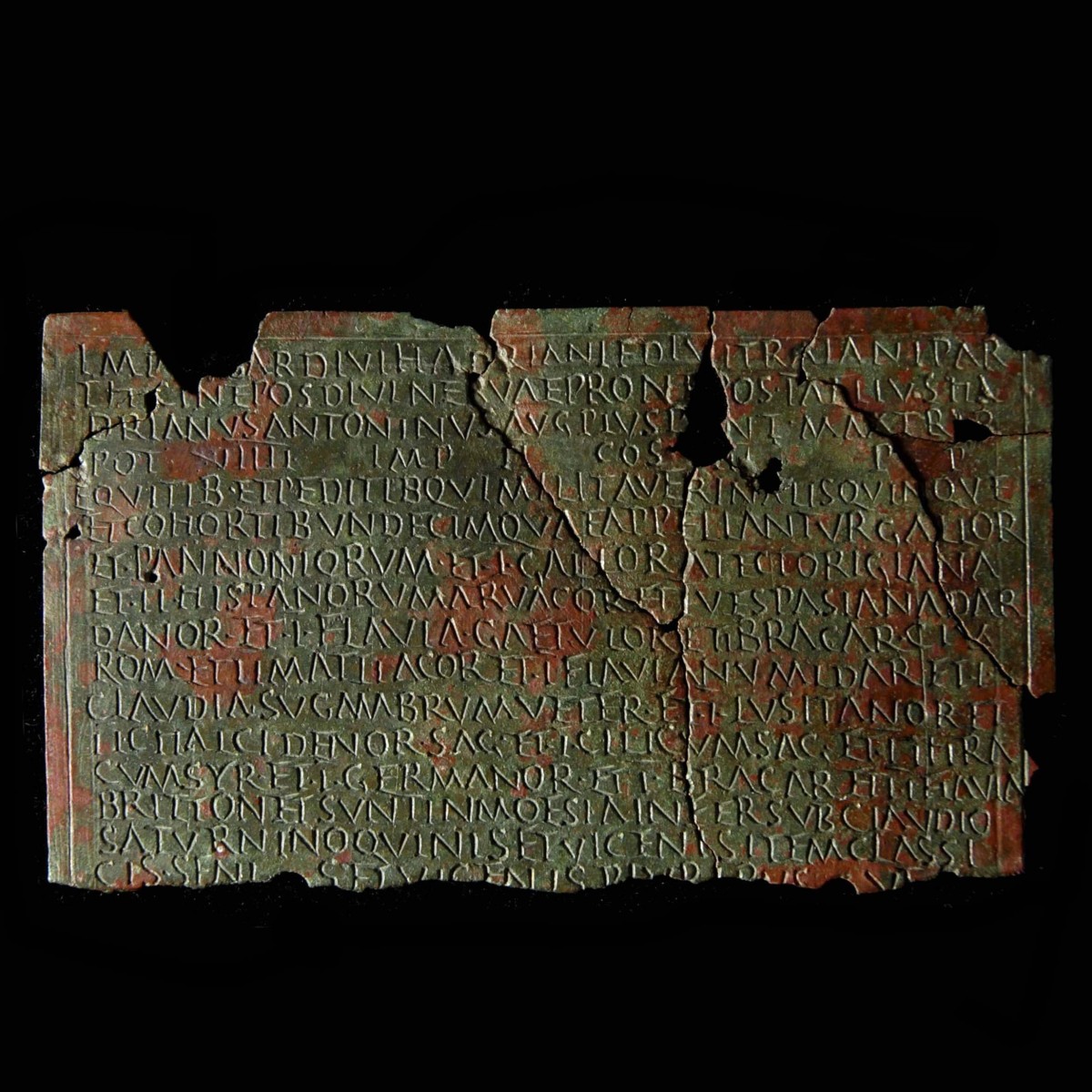
|
|
|
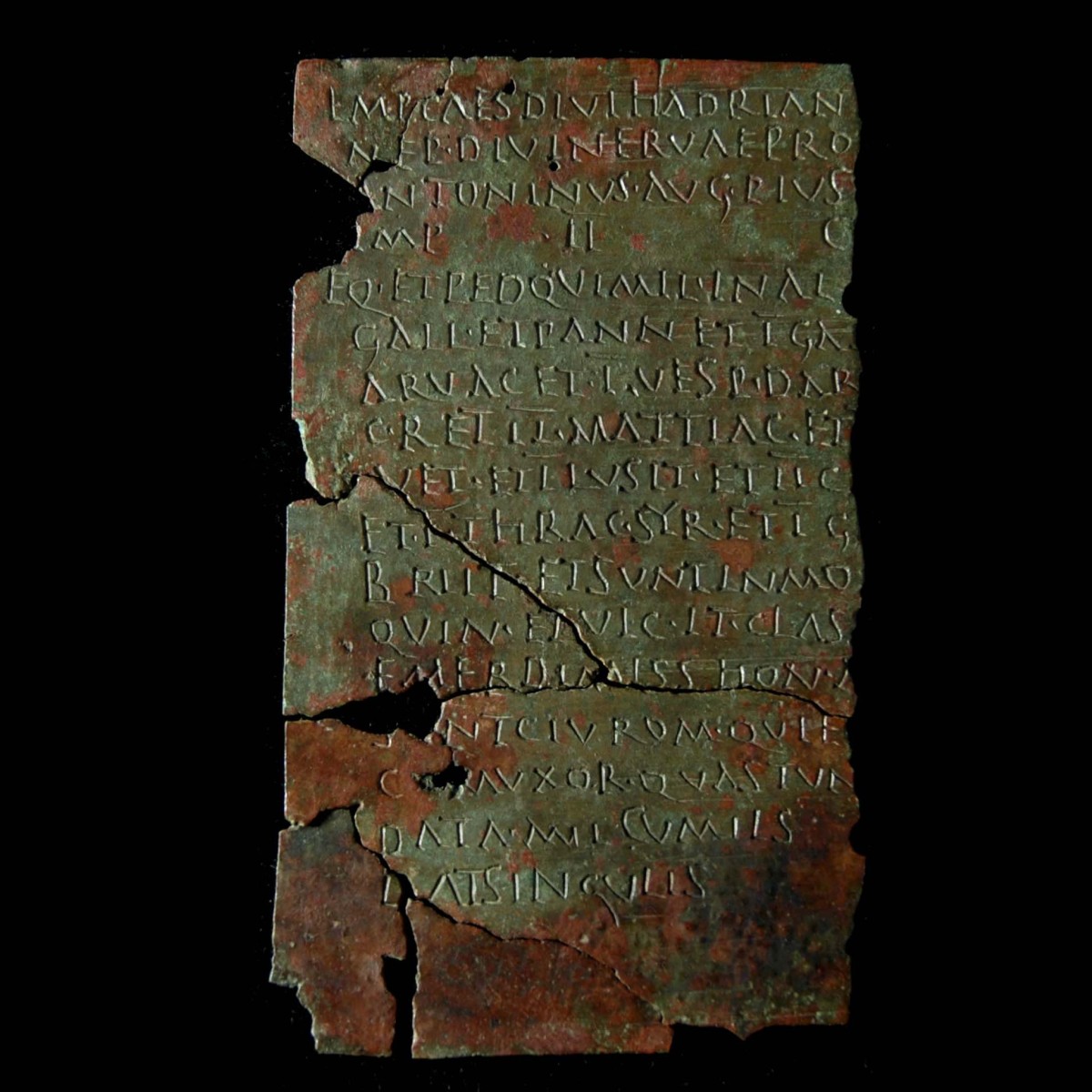
|
|
Roman Empire – early 146 A.D.
|
Six belonging fragments of a military diploma from the period of emperor Antoninus Pius. Preserved is the upper half of Tabella I. from a constitution for Moesia inferior from the year 146 A.D. The diploma has a special meaning for the research of troops of the province after Roman Dacia’s occupation. Mentioned are here namely after all five alae and eleven cohorts, as well as the governor of the province Tiberius Claudius Saturnius. See for the importance the publication Peter Weiß “Ein Diplom des Antoninus Pius für Moesia Inferior von Dez. 145/Dez. 146 – zum Truppenbestand der Provinz nach der Okkupation Dakiens” in: Zeitschrift für Papyrologie und Epigraphik 124, 1999, pages 279-286. Also published in: M. Roxan, P. Holder “Roman Military Diplomas IV (2003)”, p. 516 f., No. 270.
|
Provenance: From the German collection Peter Weiß, acquired between 1967 and 2015.
Dimensions: 6.5 cm x 11.4 cm
Price: 8 000 Euro
|
|
|
|
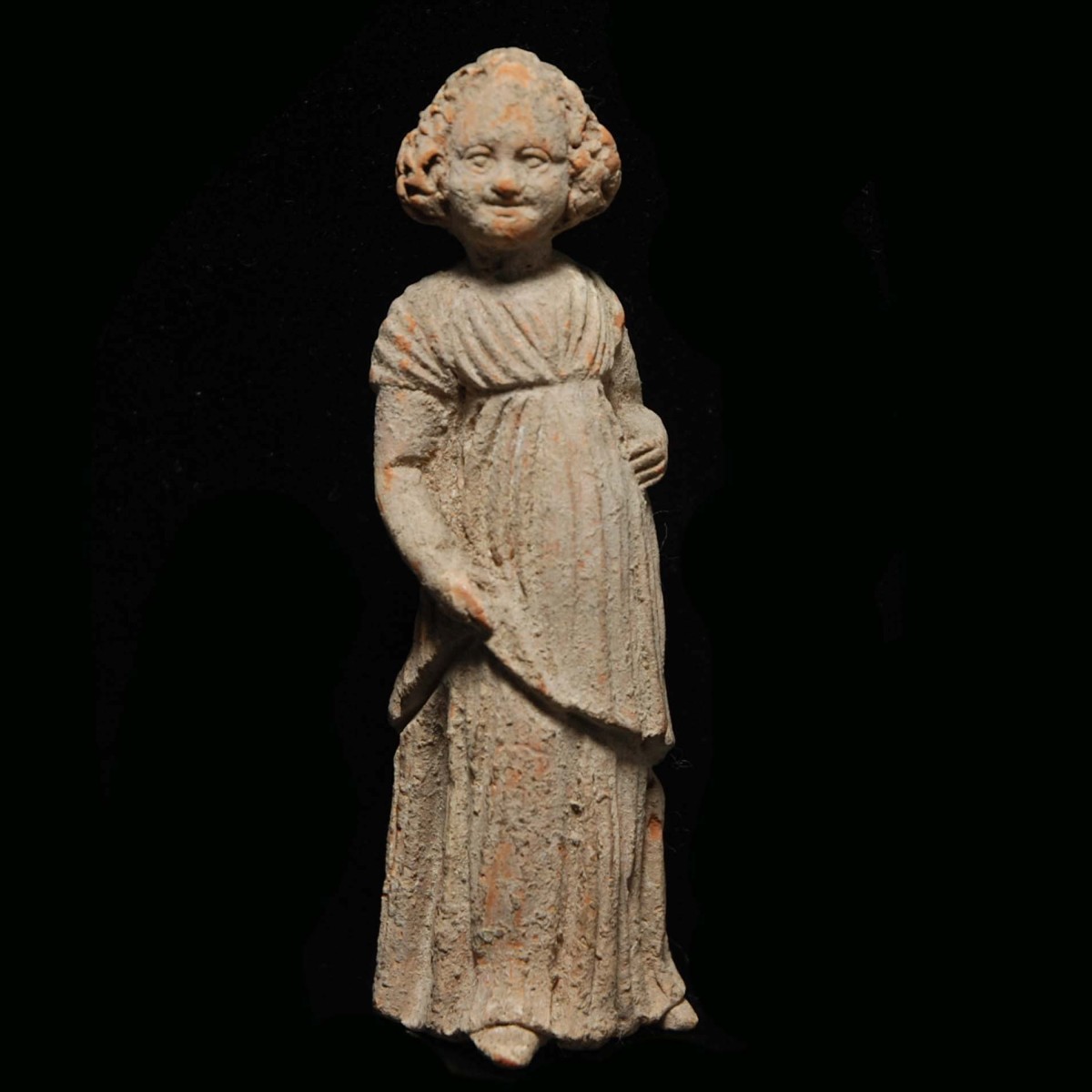
|
|
|
|
|
|
Greece – 4th-3rd century B.C.
|
Very graceful terracotta statuette of a girl with a coquettish expression of an adolescent. The girl stands slightly to the left, she wears a floor-length chiton and above it a himation, which she lifts at hip height with her right hand. She has childish chubby cheeks, she has bent her left arm, and placed her hand on her round belly. The facial expression is coquettish, the gaze confidently directed straight ahead. The girl has half-length hair, with thick curls over her ears. A wonderful work from Tanagra. With an old collection number 10 at the bottom. With a TL test of 23 October 2021.
|
Provenance: From the private collection of the French archaeologist Louis-Gabriel Bellon (1819-1899). For over 120 years in the family estate.
Dimensions: 9.5 cm high
Price: 3 800 Euro
|
|
|
|
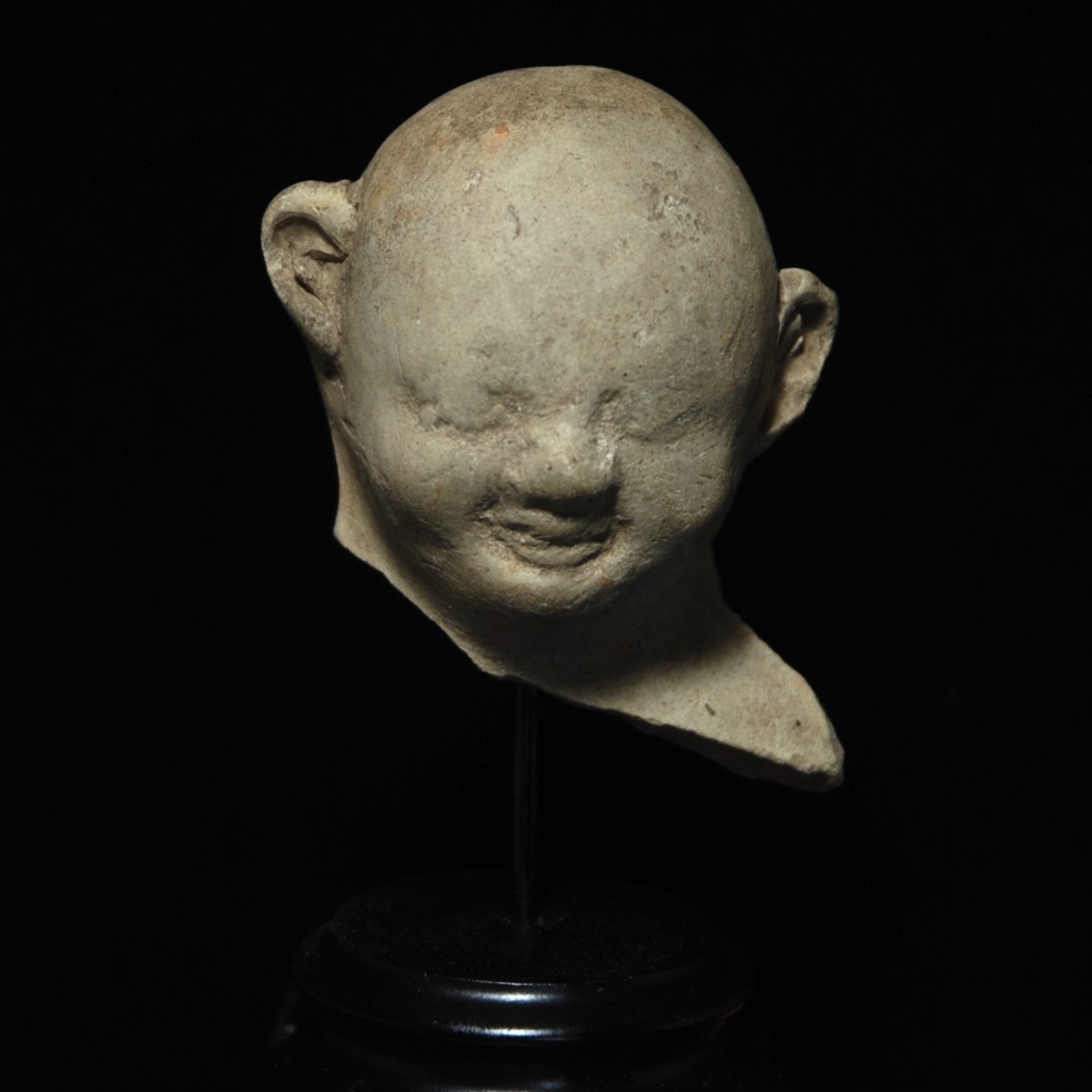
|
|
Gallia – 1st-2nd century A.D.
|
Rare terracotta head of the Gallo-Roman god Risus. The childlike tutelary deity with his unique, eponymous smile, the typically bald, large head and protruding ears. Statuettes of this Gallo-Roman god are known since the 19th century and were especially found in Romano-Celtic temples (fanum), such as in Northern French Mesnil-Saint-Nicaise. The French archaeologist Michaël Martin assumes that Risus statuettes were placed close to cradles to stop the babies’ crying. Its broad smile should also scare off evil ghosts. On the back a collection label with the inscription "Thérouane 316", which most probably indicates the finding site, the place Thérouane in the Départment Pas-de-Calais in der Region Hauts-de-France. Mounted.
|
Provenance: From the private collection of the French archaeologist Louis-Gabriel Bellon (1819-1899). For over 120 years in the family estate.
Dimensions: 6.5 cm high
Price: 1 200 Euro
|
|
|
|
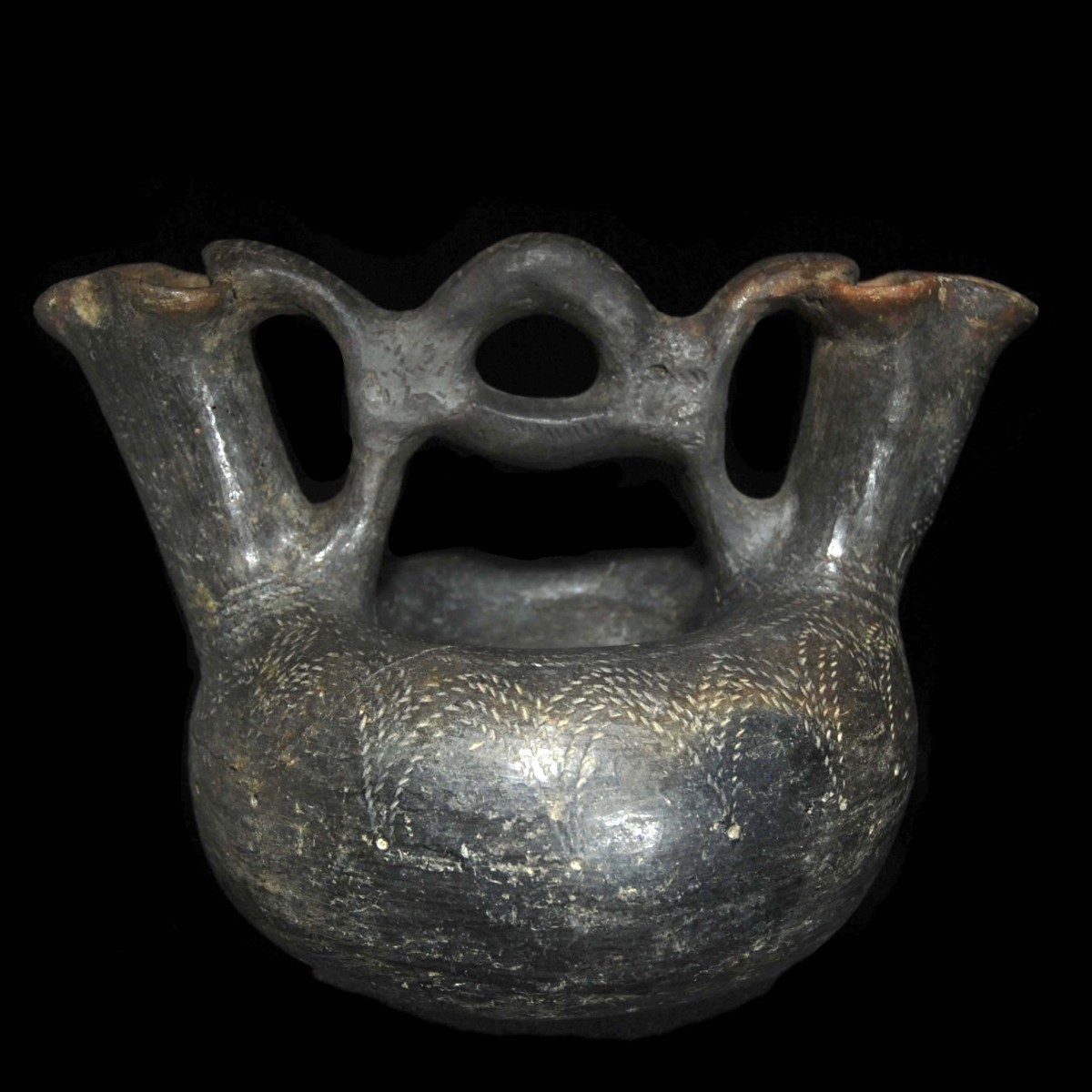
|
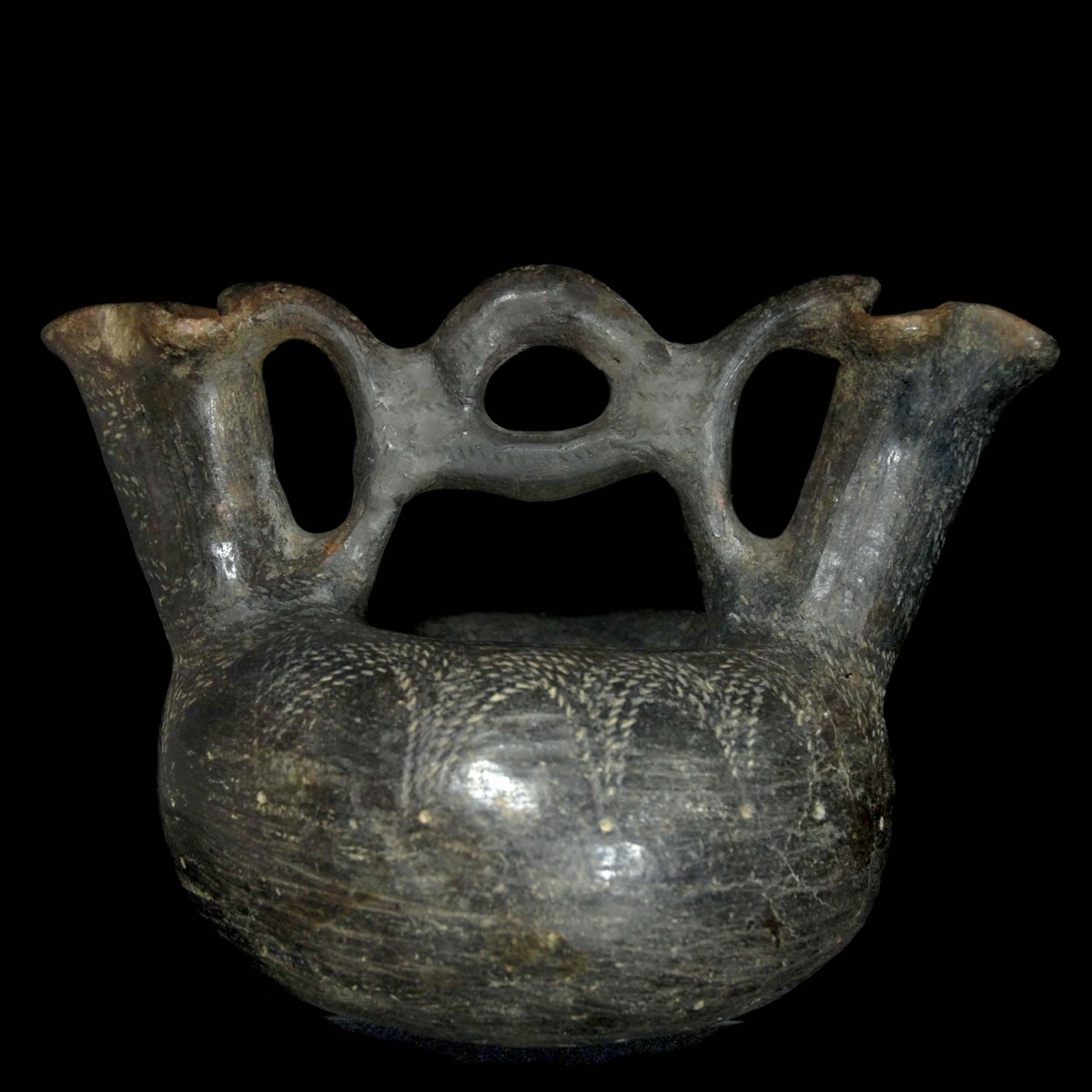
|
|
Etruria – 2nd half of 8th century B.C.
|
Early Etruscan or Villanovan ring askos of the Impasto ware. The massive ring-shaped vessel has two spouts pulled outwards, one with a sieve function. The spouts are connected on the rim and on the neck with an open handle. The corpus and the necks of the spouts are decorated with impressed line decor. A large vessel in a rare form.
|
Provenance: German private collection R. K., Hessen, acquired prior to 1980.
Dimensions: 15.5 cm high; 21.5 cm handle diameter
Price: 4 000 Euro
|
|
|
|
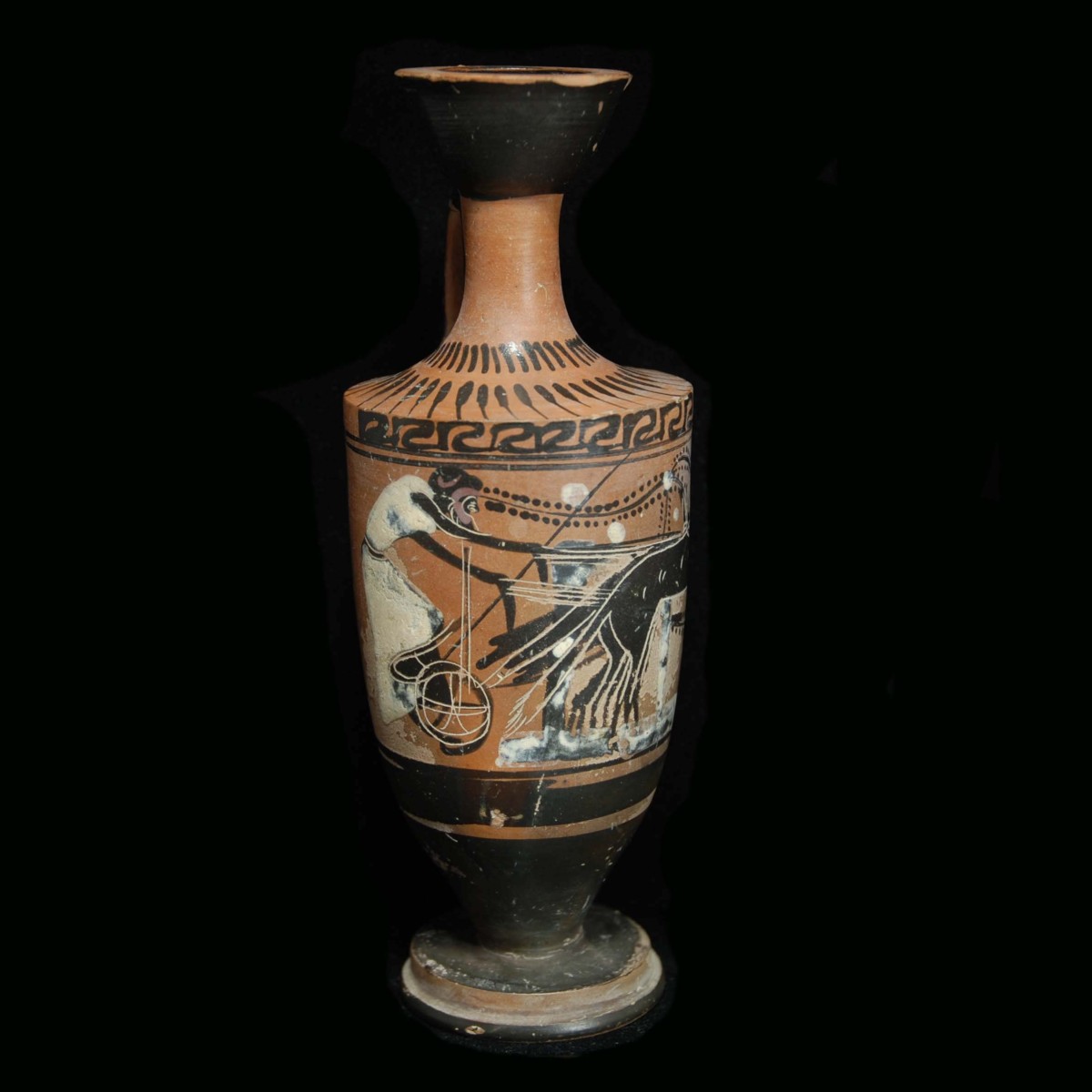
|
|
|
|
|
|
Greece – Early 5th century B.C.
|
Black-figured lekythos on a profiled, broad stand ring. The image area depicts a quadriga with four black horses, which raise their front legs. In the chariot a bearded charioteer in a long white vestment holds the reins. Above meander. On the neck tongue and on the shoulder ray decoration. Lekythoi were made to store oil which was used in the classic world for a variety of purposes. While larger examples were normally used for storing olive oil, smaller, more delicate examples such as the present one were reserved for the bathroom to keep precious essences with exquisite aromas. With an old collection label with the number 298.
|
Provenance: From the private collection of the French archaeologist Louis-Gabriel Bellon (1819-1899). For over 120 years in the family estate.
Dimensions: 15.6 cm high
Price: 4 400 Euro
|
|
|
|
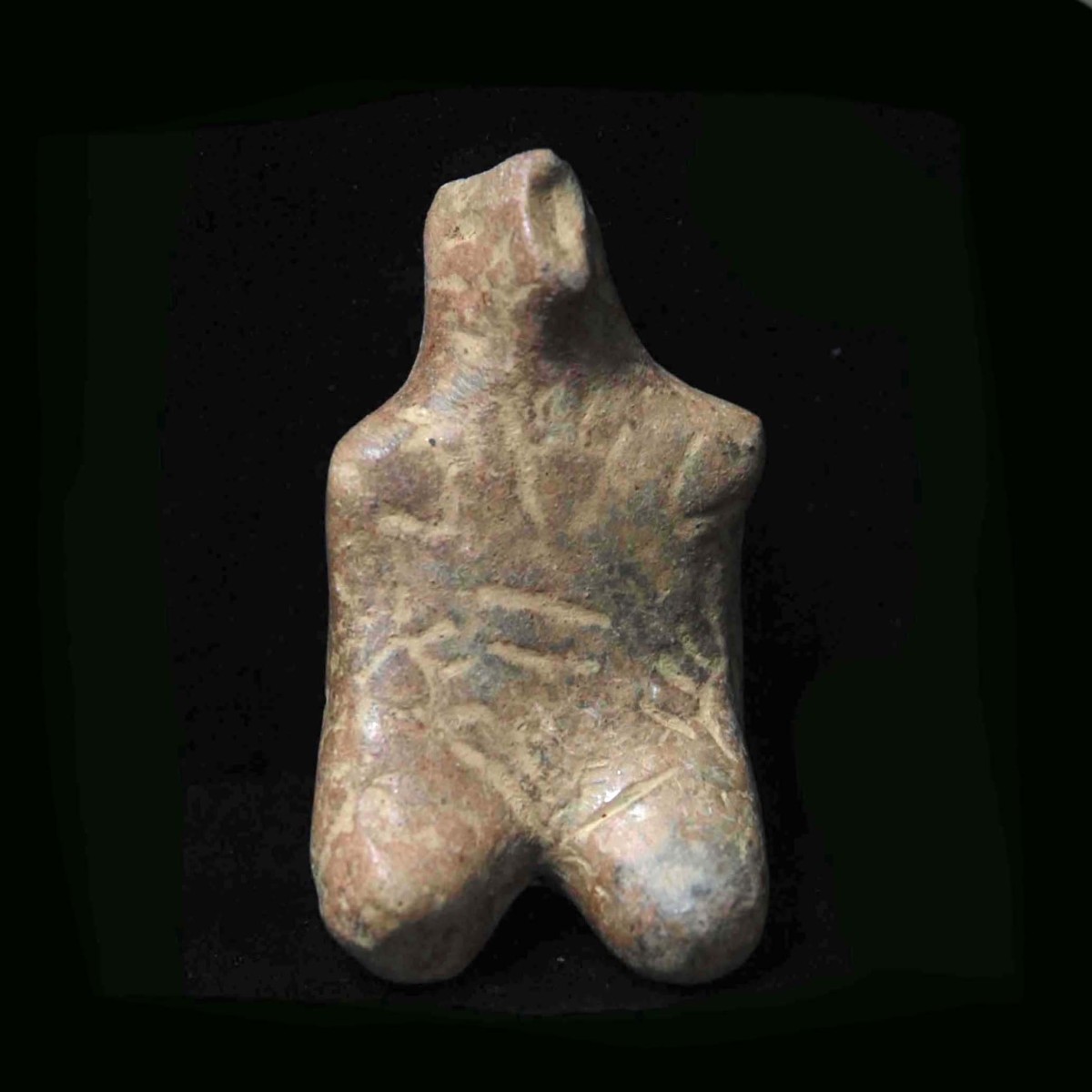
|
|
|
|
|
|
Southeastern Europe – 5500-4500 B.C.
|
A seated statuette of the Vinča culture with protruding stump arms and a far protruding buttock, which is formed to a rising hump. The head is small and long, the mouth trumpet-shaped. The eyes are punched into the clay. The back of the head is rectangular and flat. The figure is on the sides, on the belly and on the neck abundantly decorated with incisions. At the bottom and on the hump a not very deep perforation. A rare depiction. From the region of Supska-Stublina.
|
Provenance: Viennese private collection Dusan Jovanovic (1956-2015), acquired 1970 from Galerie Erwin Richter in Wiener Neustadt, Austria. With a provenance confirmation by Erwin Richter. Since then in a family estate.
Dimensions: 6.8 cm high
Price: 2 200 Euro
|
|
|
|
|
|
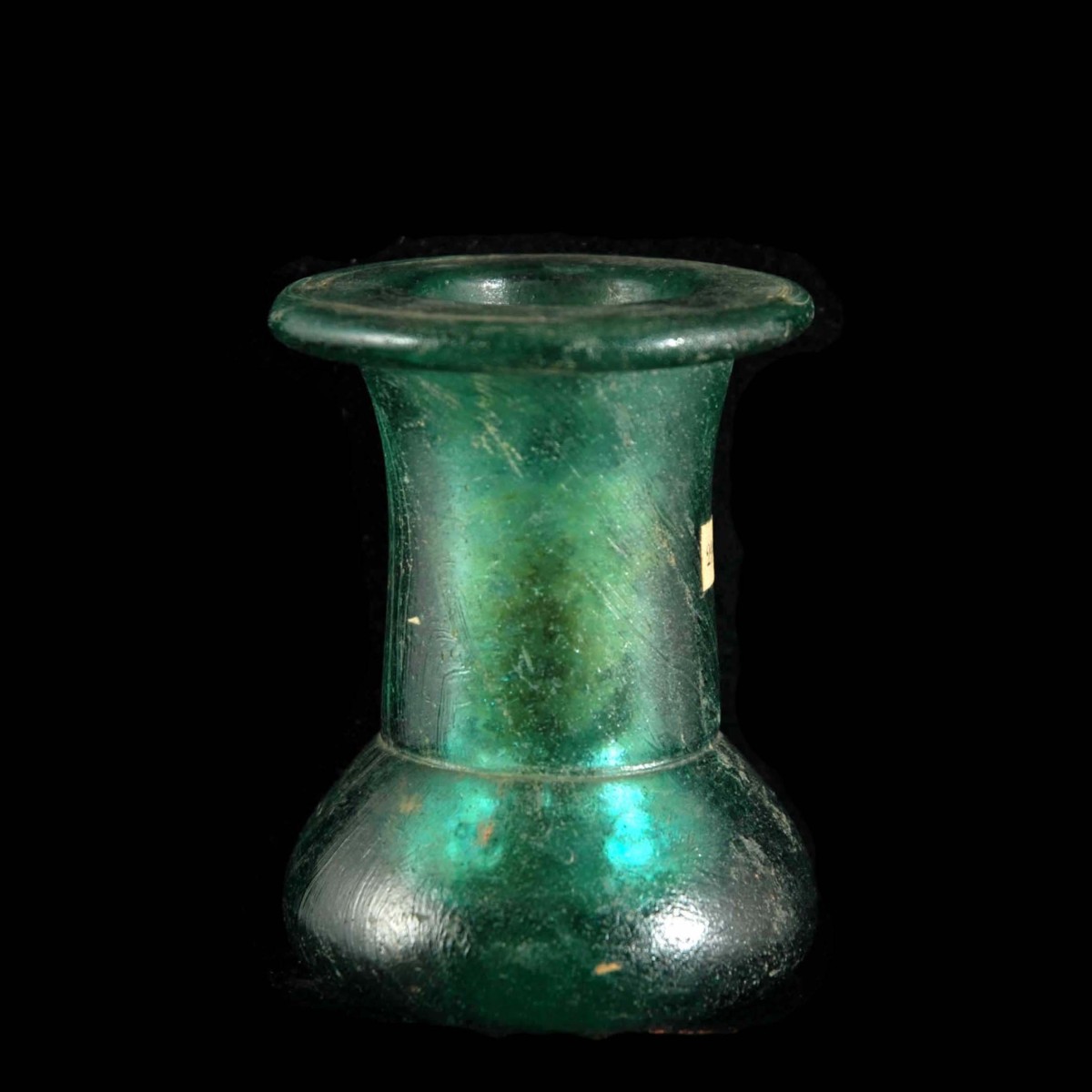
|
|
Roman Empire – 2nd century A.D.
|
Magnificent unguentarium of thick-walled, green glass. The corpus compressed pear-shaped, the base flat, curved inwardly in a circular shape. The neck is long and cylindrical, the rim horizontally protruding and on the edge thickened. Wonderful streaks which create a certain elegance. On the side an old collection label with the number 216.
|
Provenance: From the private collection of the French archaeologist Louis-Gabriel Bellon (1819-1899). For over 120 years in the family estate.
Dimensions: 20 cm high
Price: 800 Euro
|
|
|
|
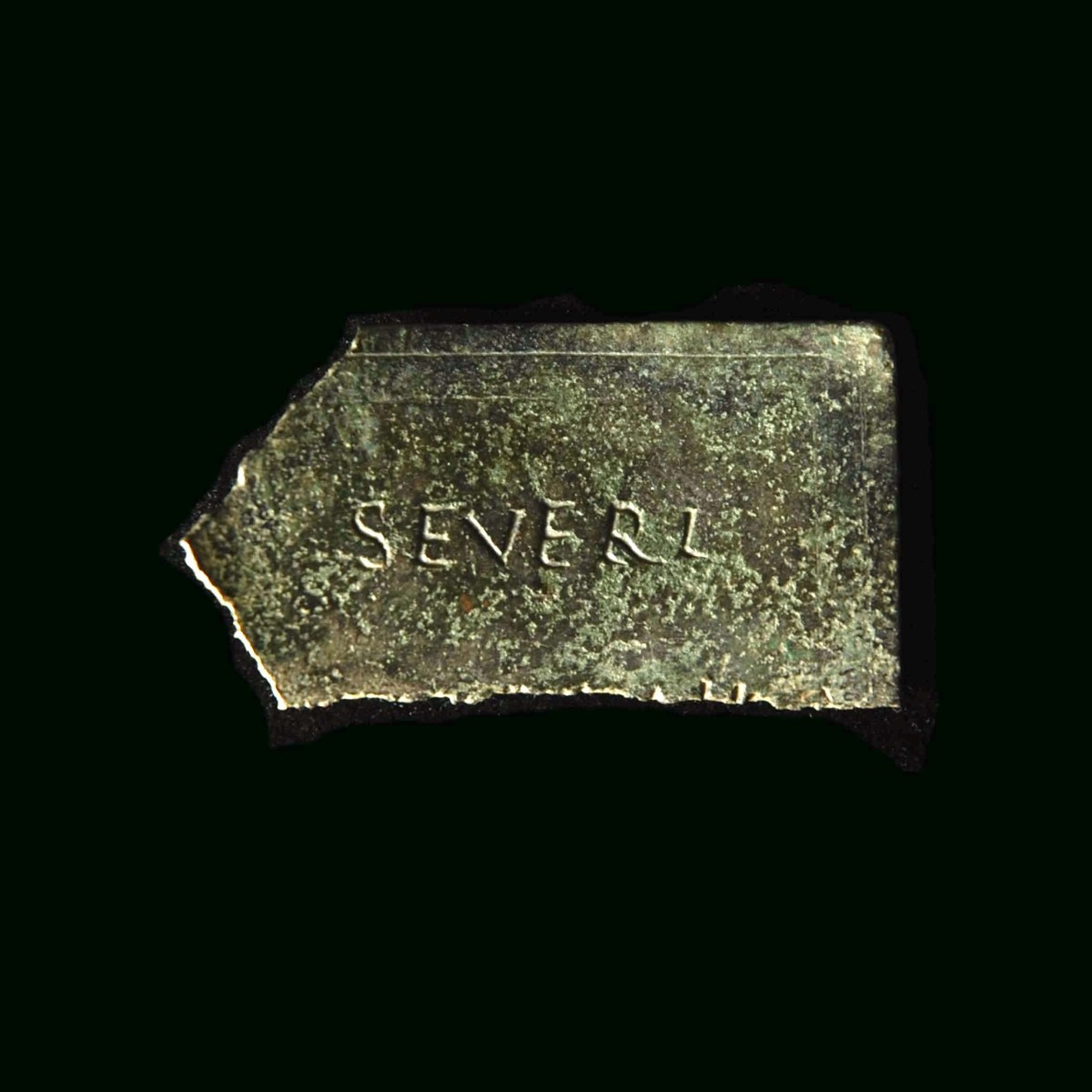
|
|
|
|
Roman Empire – 2nd-3rd century A.D.
|
Fragment of a military diploma of the right upper corner of Tabella II. Preserved is the name “Severi” who is one of the seven witnesses mentioned during the awarding of the diploma. Along the edges finely drawn bordering lines.
|
Provenance: From the German collection Peter Weiß, acquired between 1967 and 2015.
Dimensions: 3 cm x 5.4 cm
Price: 500 Euro
|
|
|
|
Five Hellenistic Grotesque Heads from the Collection of the French Archeologist Louis-Gabriel Bellon (1819-1899):
|
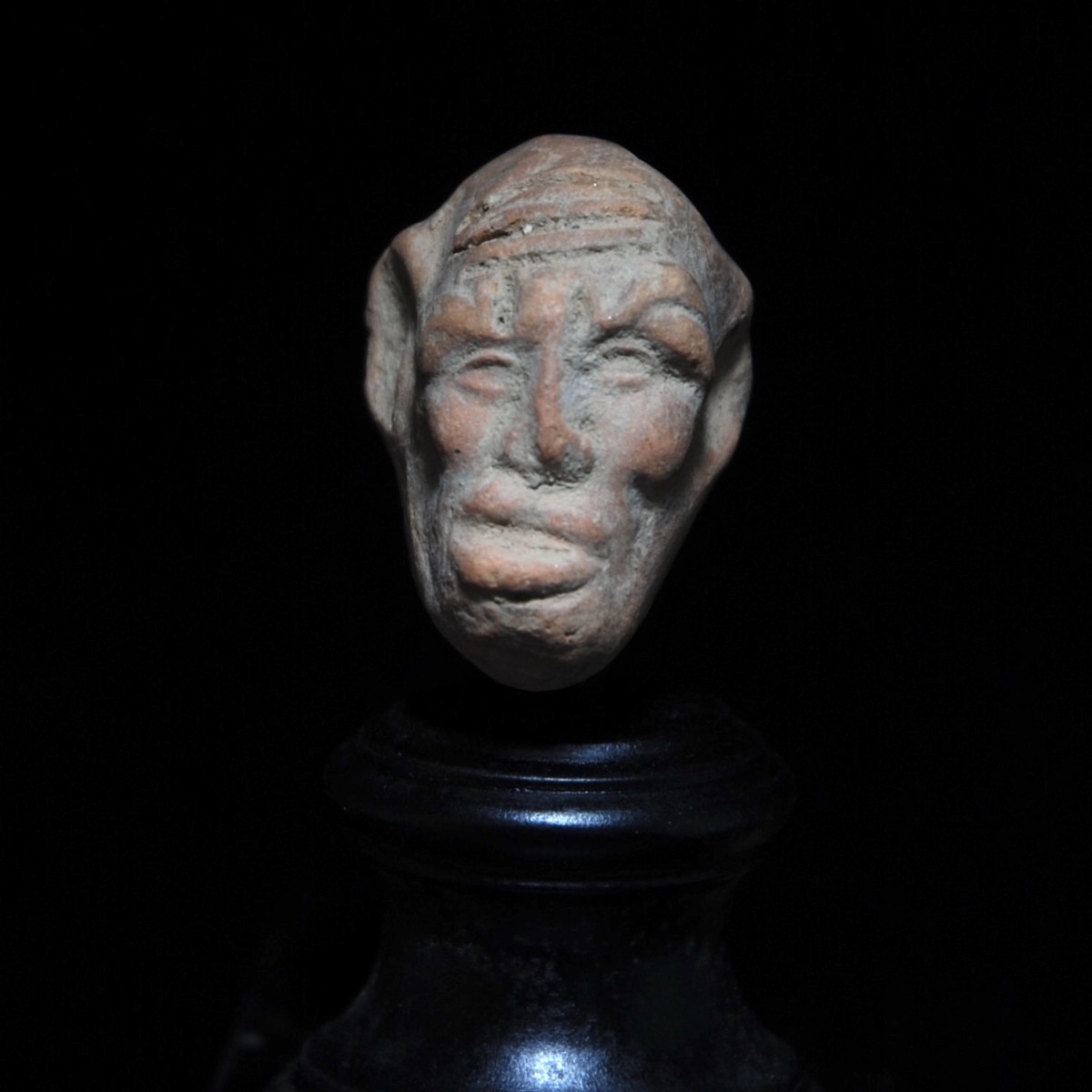
|
|
|
|
|
|
Greece – 2nd century B.C.
|
Sculptural small terracotta head of a grotesque with a twisted face to the right and acromegalic features. The man with a bald head has deep forehead wrinkles, bulging brows and a slate, over-large mouth with a wide protruding lower lip. The eyes are small, the left due to the misalignment of the face significantly raised. The back of the head is pulled far back and rounded, the ears are also acromegalic. An exceedingly expressive head. See for type the terracotta statuette in the Metropolitan Museum of Art in New York with the Accession Number 2000.667.1. Possibly from Smyrna. Mounted.
|
Dimensions: 4 cm high
Price: 800 Euro
|
|
|
|
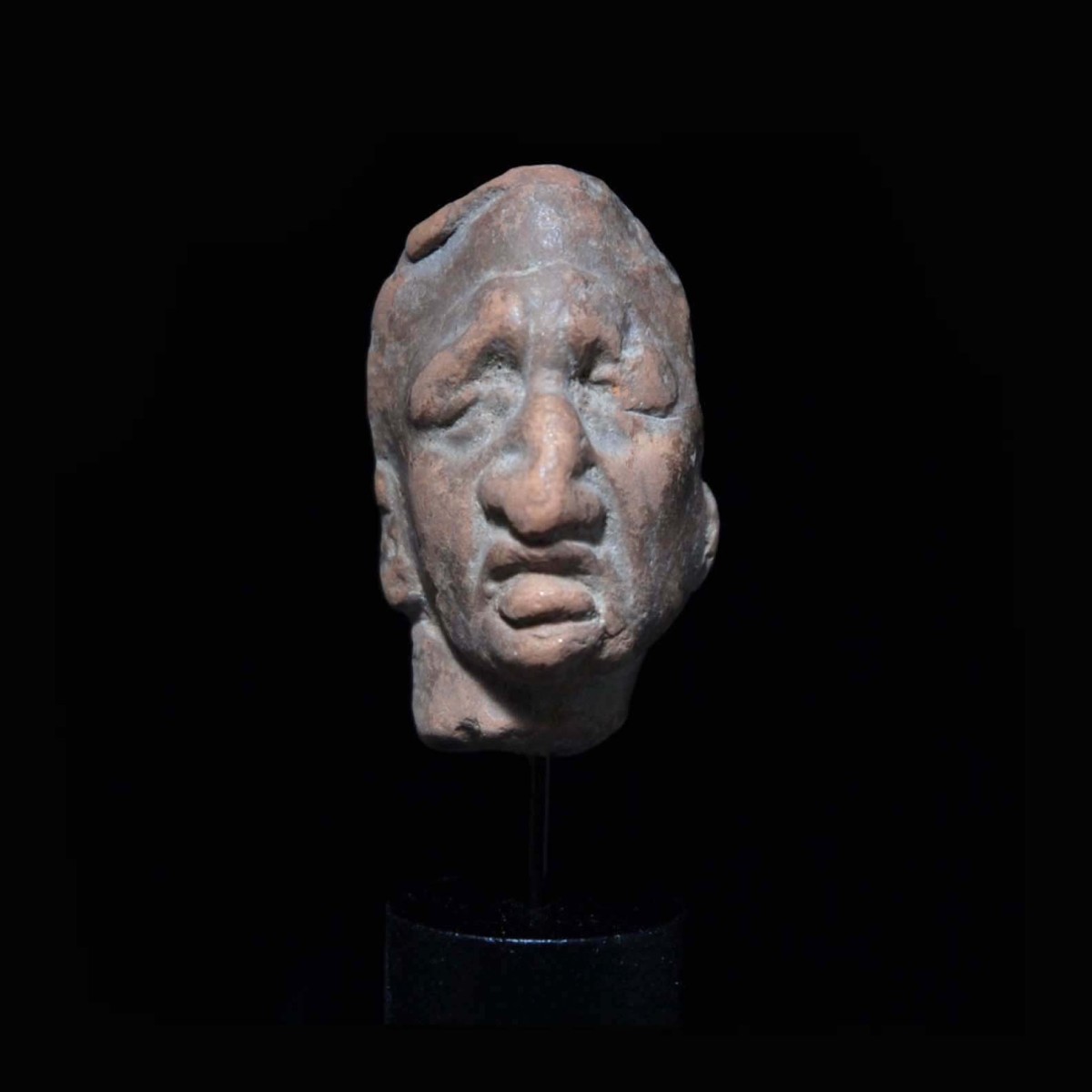
|
|
|
|
|
|
Greece – 2nd century B.C.
|
Very strikingly distinct face of a grotesque. The man with a suffering expression has a large hook nose framed by nasolabial folds, bulging brows drawn upwards with forehead wrinkles above and narrow eyes. The mouth with thick lips is slightly open. The right, still preserved ear sits deep. On the notched inside back the fingerprints of the sculpturer are preserved. Possibly from Smyrna. Mounted.
Dimensions: 4 cm high
Price: 600 Euro
|
|
|
|
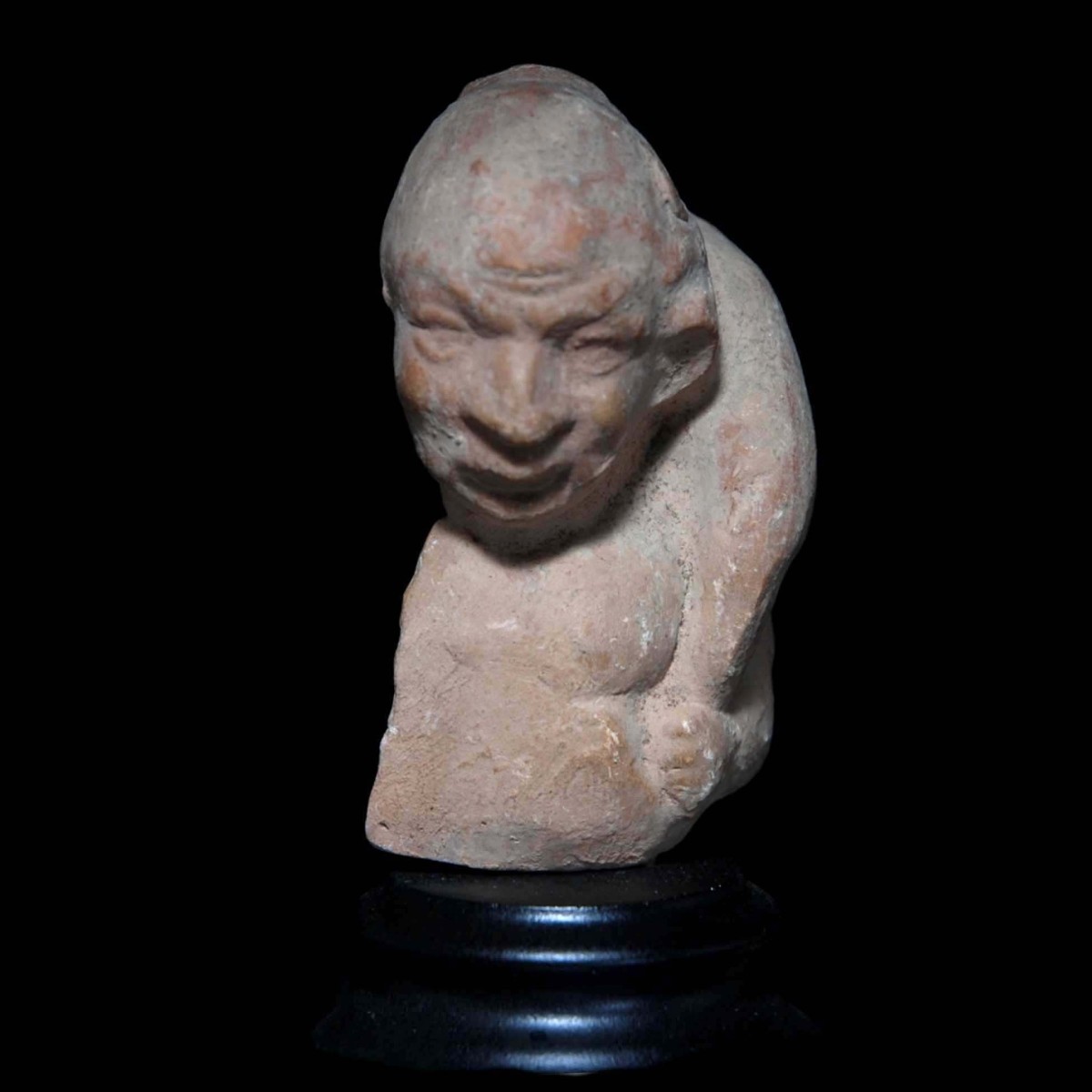
|
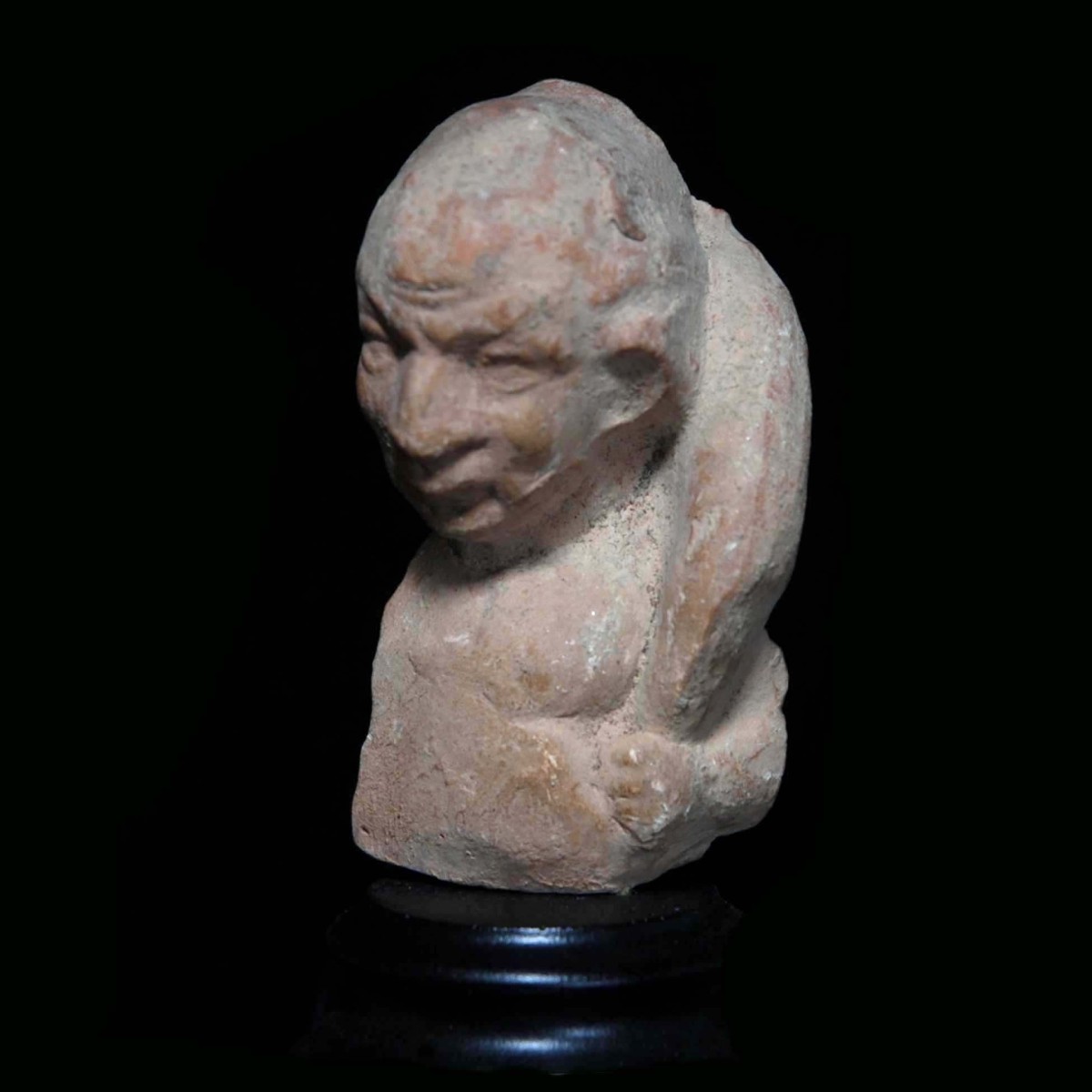
|
|
Greece – 2nd century B.C.
|
Hellenistic terracotta fragment of a grotesque or actor who holds a bag or wineskin. The face with acromegalic features which are brilliantly expressed with the extra-large nose, protruding ears and bulging brows. The actor, possibly a slave, has the tube in a bent position put over his shoulder and holds it with the left hand below his chest. The upper body is undressed, the head bald. The firmly closed mouth with a slightly overbite and the narrow eyes underline the weight of the burden on the man’s shoulders. Possibly from Smyrna. See for the type the statuette in the Museum of Fine Arts Budapest with the inventory number T.337. Mounted.
Dimensions: 6.8 cm high
Price: 800 Euro
|
|
|
|
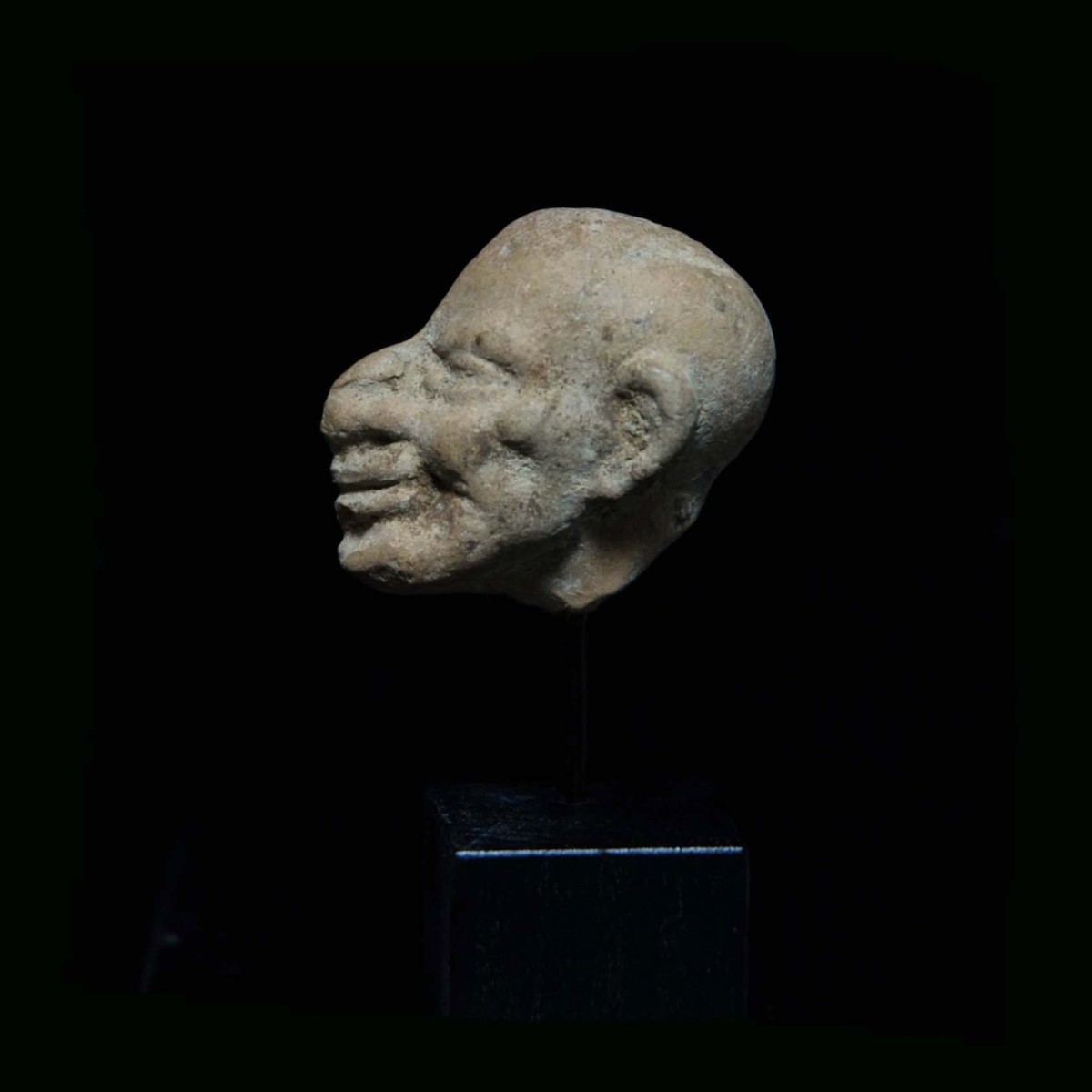
|
|
Greece – 2nd century B.C.
|
Small relief terracotta head of a bald grotesque with an over-large crook nose, broad mouth formed to a smile and large, protruding ears. The eyes are slightly narrow. The high cheekbones and the deep dimple on the cheek provide yet a friendly expression to the angular face. See for the type of the small head in the Metropolitan Museum of Art in New York with the Accession Number 2000.667.2b. Mounted.
Dimensions: 2.7 cm x 3.2 cm
Price: 500 Euro
|
|
|
|
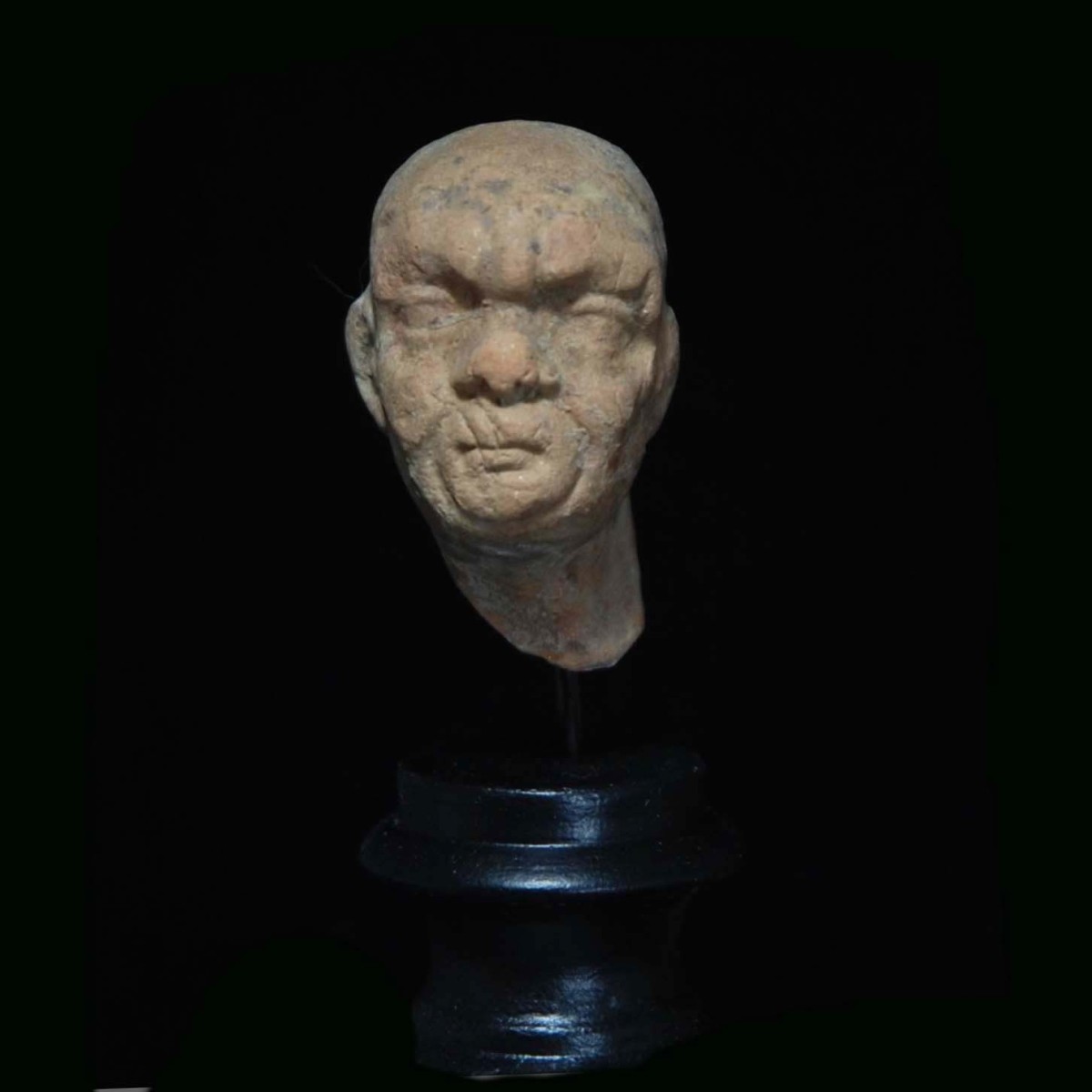
|
|
Greece – 2nd century B.C.
|
Strikingly distinct face of a grotesque. The man with a bald head, bulging brows and deep frown lines. The cheekbones and jaw are prominent, on the sides deep mentolabial folds. The ears are slightly protruding, the chin formed to a double chin by the thick neck. On the flat back of the head the collection number 215. Mounted.
Dimensions: 3.4 cm high
Price: 600 Euro
|
|
|
|
|
|
Prosit Neujahr! Oder wie die Römer sagen würden: "Annum novum faustum felicem!"
|
|
|
|
|
Unser Highlight des Monats:
|
|
Römisches Reich/Arabia Felix – 1. Jahrhundert n. Chr.
|
Bedeutende und hochqualitative Bronzebüste des Dionysos mit zweizeiliger Inschrift über der Brust. Der kraftvoll dargestellte Gott mit nacktem Oberkörper und fein modellierter Brust- und Oberarmmuskulatur. Der Kopf nach rechts gewandt und im Stil der hellenistischen Alexander-Porträts in die Ferne blickend. Dionysos hat das dichte Haar in der Mitte gescheitelt und hinten zu einem Knoten gebunden. Lange Strähnen fallen ihm links und rechts weit über die Schulter. Der Gott trägt einen Haarkranz aus Trauben und Blättern, die seinen Kopf schmücken. In die Brust ist eine zweizeilige Weiheinschrift in südarabischen Buchstaben graviert. Die Inschrift lautet: „Amm’aman Yuha’min Watar hat (diese Büste) in Hirran aufgestellt.“ Dass der nicht königliche Name Amm’aman mit gleich zwei Zunamen, nämlich Yuha-min und Watar, versehen ist, ist laut dem weltweit führenden Experten für sabäische Inschriften Francois Bron von außergewöhnlicher Seltenheit. Die Büste feinster Qualität wurde von Bron in der Sammlung Moussaieff besichtigt und in „Ètudes Bibliques et Proche-Orient ancien – Mélanges offerts au Père Paul Feghali“, Subsidia 1, Seite 40, Beirut 2002, veröffentlicht und beschrieben. Gesockelt.
|
Provenienz: Privatsammlung Shlomo Moussaieff (1925-2015), Israel. Erworben zwischen 1948 und 2000. Mit Kopie der Publikation von Francois Bron.
Höhe: 18,5 cm
Price: 28.000 Euro
|
|
|
|
Ausgewählte Kunstwerke des Monats:
|
|
Ägypten – 18. Dynastie, Amarna-Periode, 1351-1334 v. Chr.
|
Großes Kalkstein-Fragment aus der Amarna-Periode unter der Herrschaft des Pharaos Echnaton. Dargestellt sind zwei Figuren, die sich zueinander beugen. Die rechte, männliche Figur trägt einen langen, glatten Kilt und stützt eine große Vase auf einem Dreifuß ab. Die linke Figur streckt ihre langen Arme ebenfalls in Richtung der Vase. Es ist möglich, dass die rechte Figur, möglicherweise ein Mitglied der königlichen Familie, beim Verlassen eines Gebäudes gezeigt wird, nach einem Modell, das auch im Königsgrab von El-Amarna dokumentiert ist. Vergleiche zu dieser Annahme G. Thorndike Martin, “The Royal Tomb at El-Amarna”, London, 1989, Tafel 34. Die Gesichter mit den ellipsenförmigen Augen, den prägnanten Nasen und Kinns sind genauso typisch für die Kunst der Amarna-Periode wie die überlangen, schlanken Arme und Glieder. Gesockelt.
|
Provenienz: New Yorker Privatsammlung S. Carroll, erworben 1969. Danach Bonhams London vom 28. November 2017, Los 16.
Dimensionen: 23,5 cm x 38 cm
Preis: 28.000 Euro
|
|
|
|
|
Königreich Saba – 3.-2. Jahrhundert v. Chr.
|
Stilisierte Gesichtstele eines bärtigen Mannes mit ovalem Kopf. Die Nase ist lang und dünn, der lächelnde Mund schmal. Von den ausgearbeiteten Ohren ausgehend, begrenzt ein dünner Bartstreifen die untere Gesichtshälfte. Der Haaransatz ist ausgearbeitet, die Haare sind durch kleine Gravuren lockig angedeutet. Die Augenhöhlen ergeben sich aus dem rechten Winkel, den Nase und Augenbrauen bilden. Hochstilisierter Kopf mit starkem Ausdruck aus früharabaischer Zeit. Vergleiche zum Typus die Gesichtstelen der Sammlung Eduard Glaser im Kunsthistorischen Museum in Wien. Aufgrund der Sammlungsgeschichte dieses Kopfes, der sich zumindest seit 80 Jahren in Wiener Familienbesitz befand, kann angenommen werden, dass dieses Exemplar ursprünglich ebenfalls mit Glaser seinen Weg nach Wien fand. Gesockelt.
|
Provenienz: Sammlung Johann Emil Storm (1902-1983), durch Geschenk in den 1930er Jahren übernommen. Ursprünglich wohl aus der Sammlung Eduard Glaser, Ende 19. Jahrhundert, Wien.
Höhe: 17 cm
Preis: 12.000 Euro
|
|
|
|
|
Römisches Reich – Anfang 146 n. Chr.
|
Sechs zusammengehörige Fragmente eines Militärdiploms aus der Zeit des Kaisers Antoninus Pius. Erhalten ist die obere Hälfte der Tabella I. von einer Konstitution für Moesia inferior aus dem Jahr 146 n. Chr. Das Diplom hat besondere Bedeutung zur Erforschung des Truppenbestands der Provinz nach der Okkupation Dakiens. Erwähnt werden hier nämlich immerhin fünf Alae und elf Kohorten sowie der Statthalter der Provinz Tiberius Claudius Saturnius. Siehe zur Bedeutung die Publikation Peter Weiß „Ein Diplom des Antoninus Pius für Moesia Inferior von Dez. 145/Dez. 146 – zum Truppenbestand der Provinz nach der Okkupation Dakiens“ in: Zeitschrift für Papyrologie und Epigraphik 124, 1999, Seiten 279-286. Ebenfalls publiziert in: M. Roxan, P. Holder „Roman Military Diplomas IV (2003)", S. 516 f., Nr. 270.
|
Provenienz: Aus der deutschen Sammlung Peter Weiß, erworben zwischen 1967 und 2015.
Dimensionen: 6,5 cm x 11,4 cm
Preis: 8.000 Euro
|
|
|
|
|
Griechenland – 4.-3. Jahrhundert v. Chr.
|
Überaus anmutige Terrakotta-Statuette eines Mädchens mit dem koketten Ausdruck einer Halbwüchsigen. Das Mädchen steht leicht nach links gewandt, sie trägt einen bodenlangen Chiton und darüber ein Himation, das sie mit der rechten Hand in Hüfthöhe leicht anhebt. Sie hat kindliche Pausbacken, den linken Arm hat sie angewinkelt, die Hand auf das rundliche Bäuchlein gelegt. Der Gesichtsausdruck ist kokett, der Blick selbstbewusst geradeaus gerichtet. Das Mädchen hat halblanges Haar, mit dichten Locken über den Ohren. Eine wunderbare Arbeit aus Tanagra. Mit alter Sammlungsnummer 10 auf der Unterseite. Mit TL-Test vom 23. Oktober 2021.
|
Provenienz: Aus der Privatsammlung des französischen Archäologen Louis-Gabriel Bellon (1819-1899). Seit über 120 Jahren in Familienbesitz. Mit TL-Test.
Länge: 9,5 cm
Preis: 3.800 Euro
|
|
|
|
|
Gallien – 1.-2. Jahrhundert n. Chr.
|
Seltener Terrakottakopf des gallischen Gottes Risus. Der kindliche Schutzgott mit seinem einzigartigen, namensgebenden Lächeln, dem typisch kahlen, großen Kopf und abstehenden Ohren. Statuetten dieses gallischen Gottes sind seit dem 19. Jahrhundert bekannt und wurden vor allem in keltischen Umgangstempeln (Fanum) etwa im nordfranzösischen Mesnil-Saint-Nicaise gefunden. Der französische Archäologe Michaël Martin geht davon aus, dass Risus-Statuetten in der Nähe von Wiegen platziert wurden, um das Schreien der Babys zu stoppen. Ihr breites Lächeln sollte auch böse Geister verscheuchen. Auf der Rückseite ein Sammlungsetikett mit der Inschrift „Thérouane 316“, was auf den Fundort, den Ort Thérouanne im Départment Pas-de-Calais in der Region Hauts-de-France hinweisen dürfte. Gesockelt.
|
Provenienz: Aus der Privatsammlung des französischen Archäologen Louis-Gabriel Bellon (1819-1899). Seit über 120 Jahren in Familienbesitz.
Höhe: 6,5 cm
Preis: 1.200 Euro
|
|
|
|
|
Etrurien – 2. Hälfte 8. Jahrhundert v. Chr.
|
Frühetruskischer oder Villanova Ringaskos der Impasto Ware. Das massive ringförmige Gefäß mit zwei nach außen gedrehten Ausgüssen, einer davon mit Siebfunktion. Die Ausgüsse sind am Rand und am Halsansatz mit einem durchbrochenen Henkel miteinander verbunden. Der Korpus und die Hälser der Ausgüsse sind mit eingedrücktem Schnurdekor verziert. Ein großes Gefäß in einer seltenen Form.
|
Provenienz: Deutsche Privatsammlung R. K., Hessen, erworben vor 1980.
Dimensionen: Höhe 15,5 cm; Durchmesser Henkel 21,5 cm
Preis: 4.000 Euro
|
|
|
|
|
Griechenland – Anfang 5. Jahrhundert v. Chr.
|
Schwarzfigurige Lekythos auf profiliertem, breitem Standring. Die Bildfläche zeigt eine Quadriga mit vier schwarzen Pferden, die mit den Vorderläufen aufbäumen. Im Streitwagen hält ein bärtiger Wagenlenker im langen weißen Gewand die Zügel in der Hand. Darüber Mäander. Am Hals Zungen, an der Schulter Strahlendekor. Lekythoi wurden zur Lagerung von Öl verwendet, das in der klassischen Welt für eine Vielzahl von Zwecken verwendet wurde. Während größere Exemplare normalerweise für die Aufbewahrung von Olivenöl bestimmt waren, waren kleinere, zartere Exemplare wie dieses dem Bad vorbehalten, um kostbare Essenzen mit edlen Aromen aufzubewahren. Mit altem Sammlungsetikett mit der Nummer 298.
|
Provenienz: Aus der Privatsammlung des französischen Archäologen Louis-Gabriel Bellon (1819-1899). Seit über 120 Jahren in Familienbesitz.
Höhe: 15,6 cm
Preis: 4.400 Euro
|
|
|
|
|
Südosteuropa – 5500-4500 v. Chr.v. Chr.
|
Sitzende Statuette der Vinča-Kultur mit abstehenden Stummelarmen und einem hinten weit ausladenden Gesäß, das weit nach oben wie ein Buckel ausgeformt ist. Der Kopf ist schmal und lang, der Mund trompetenförmig. Die Augen sind in den Ton eingestochen. Der Hinterkopf ist eckig und flach. Die Figur ist seitlich, am Bauch und am Hals mit reichen Ritzdekor verziert. An der Unterseite und am Buckel hinten je eine nicht sehr tiefe Lochung. In dieser Darstellung selten. Aus der Gegend von Supska-Stublina.
|
Provenienz: Wiener Privatsammlung Dusan Jovanovic (1956-2015), erworben 1970 in der Galerie Erwin Richter in Wiener Neustadt. Mit Provenienzbestätigung von Erwin Richter. Seitdem in Familienbesitz.
Höhe: 6,8 cm
Preis: 2.200 Euro
|
|
|
|
|
Römisches Reich – 2. Jahrhundert n. Chr.
|
Prachtvolles Unguentarium aus dickwandigem, grünem Glas. Der Korpus gestaucht birnenförmig, die Basis flach, nach innen kreisförmig gewölbt. Der Hals ist lang und zylinderförmig, die Lippe horizontal ausladend und am Rand heiß verdickt. Herrliche Schlieren, die dem Glas eine besondere Eleganz verleihen. An der Seite ein altes Sammlungsetikett mit der Nummer 216.
|
Provenienz: Aus der Privatsammlung des französischen Archäologen Louis-Gabriel Bellon (1819-1899). Seit über 120 Jahren in Familienbesitz.
Höhe: 7 cm
Preis: 800 Euro
|
|
|
|
|
Römisches Reich – 2.-3. Jahrhundert n. Chr.
|
Fragment eines Militärdiploms der rechten oberen Ecke der Tabella II. Erhalten ist der Namen „Severi“, der einen der sieben Zeugen der Verleihung des Diploms benennt. Entlang des Randes fein gezogene Begrenzungslinien.
|
Provenienz: Aus der deutschen Sammlung Peter Weiß, erworben zwischen 1967 und 2015.
Dimensionen: 3 cm x 5,4 cm
Preis: 500 Euro
|
|
|
|
Fünf hellenistische Groteskenköpfe aus der Sammlung des französischen Archäologen Louis-Gabriel Bellon (1819-1899):
|
|
Griechenland – 2. Jahrhundert v. Chr.
|
|
Vollplastisches Terrakotta-Köpfchen eines Grotesken mit nach rechts verzogenem Gesicht und akromegalischen Zügen. Der Mann mit kahlem Haupt hat tiefe Stirnfalten, wulstige Brauen und einen schiefen, übergroßen Mund mit weit abstehender Unterlippe. Die Augen sind klein, das linke durch die Schiefstellung des Gesichts deutlich angehoben. Der Hinterkopf ist weit nach hinten gezogen und abgerundet, die Ohren ebenfalls akromegalisch. Ein überaus ausdrucksstarkes Köpfchen. Vergleiche zum Typus die Terrakotta-Statuette im Metropolitan Museum of Art in New York mit der Accession Number 2000.667.1. Wohl aus Smyrna. Gesockelt.
|
Höhe: 4 cm
Preis: 800 Euro
|
|
|
|
|
Griechenland – 2. Jahrhundert v. Chr.
|
|
Außerordentlich markant ausgeprägtes Gesicht eines Grotesken. Der Mann mit dem Ausdruck eines Leidenden hat eine große Hakennase gerahmt von Nasolabialfalten, nach oben gezogene, wulstige Brauen mit Stirnfalten darüber und zusammengekniffene Augen. Der Mund mit dicken Lippen ist leicht geöffnet. Das rechte, noch erhaltene Ohr sitzt tief. Auf der nach innen gekerbten Rückseite noch die Fingerabdrücke des Bildhauers. Wohl aus Smyrna. Gesockelt.
|
Höhe: 4 cm
Preis: 600 Euro
|
|
|
|
|
Griechenland – 2. Jahrhundert v. Chr.
|
|
Hellenistisches Terrakotta-Fragment eines Grotesken oder Schauspielers, der einen Sack oder Weinschlauch trägt. Das Gesicht mit akromegalischen Zügen, die in der übergroßen Nase, den abstehenden Ohren und den wulstigen Brauen bravourös zum Ausdruck kommen. Der Schauspieler, wohl ein Sklave, hat in gebückter Haltung den Schlauch über die Schulter gelegt und hält ihn mit der linken Hand unter der Brust fest. Der Oberkörper ist unbekleidet, der Kopf kahl. Der fest geschlossene Mund mit leichtem Überbiss und die zusammengekniffenen Augen machen die Schwere der Last auf den Schultern des Mannes deutlich. Wohl aus Smyrna. Gesockelt.
|
Höhe: 6,8 cm
Preis: 800 Euro
|
|
|
|
|
Griechenland – 2. Jahrhundert v. Chr.
|
|
Terrakotta-Reliefköpfchen eines kahlen Grotesken mit übergroßer Hakennase, breitem zu einem Lächeln geformtem Mund und einem großen, abstehenden Ohr. Die Augen sind leicht zusammengekniffen. Die hohen Backenknochen und das tiefe Grübchen in der Wange geben dem kantigen Gesicht dennoch einen freundlichen Ausdruck. Vergleiche zum Typus das Köpfchen im Metropolitan Museum of Art in New York mit der Accession Number 2000.667.2b. Gesockelt.
|
Dimensionen: 2,7 cm x 3,2 cm
Preis: 400 Euro
|
|
|
|
|
Griechenland – 2. Jahrhundert v. Chr.
|
|
Markant ausgeprägtes Gesicht eines Grotesken. Der Mann mit kahlem Haupt, wulstigen Brauen und tiefen Zornesfalten. Backenknochen und Kiefer sind kräftig, seitlich tiefe Mentolabialfalten. Die Ohren sind leicht abstehend, das Kinn vom dicken Hals zum Doppelkinn geformt. Am flachen Hinterkopf die Sammlungsnummer 215. Gesockelt.
|
Höhe: 3,4 cm
Preis: 600 Euro
|
|
|
|
|
|
|
CHRISTOPH BACHER ARCHÄOLOGIE ANCIENT ART GmbH
|
Galerie: Stubenring 20, A-1010 Wien
Showroom: Untere Viaduktgasse 55, A-1030 Wien
|
|
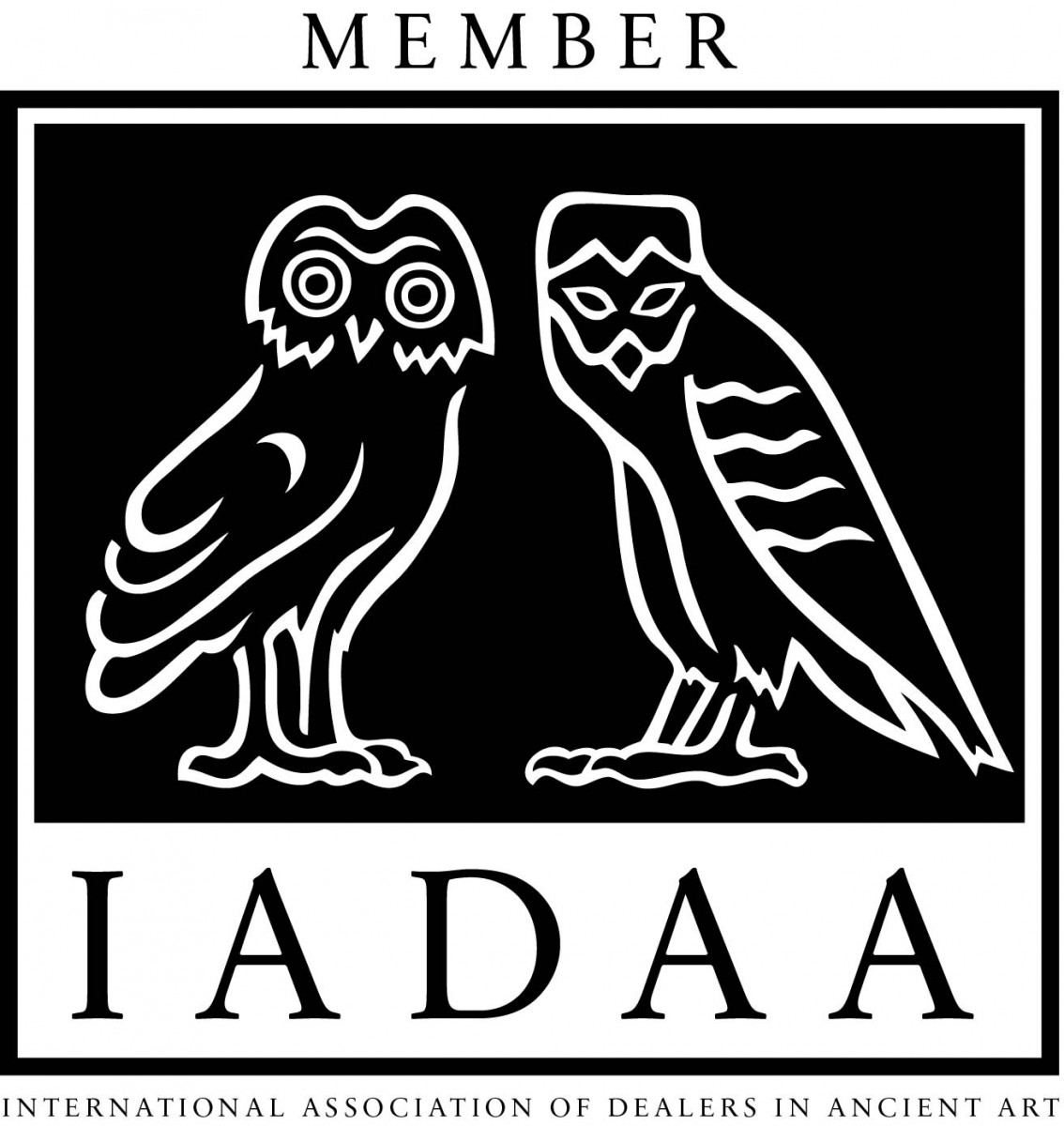
|
|
|
|